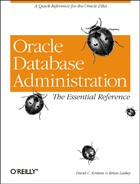Options
The Oracle options summarized in this section are currently available.
- Advanced Networking Option (ANO)
Implements additional network security and encryption. Also provides support for third-party authentication services.
- Oracle Enterprise Manager Tuning Pack
Extra-cost add-on to Enterprise Manager.
- Objects Option
Allows the creation of object classes such as object data types and methods. Implementation of the Objects Option begins the process of converting Oracle from a relational database to an object-relational database. Many of the new data types and SQL statements are available only with this option.
- Parallel Server Option
Allows loosely coupled nodes in a cluster (shared disk) or a massively parallel processor (MPP) configuration to share a common database. This allows for scalability to larger databases than could be supported on a single computer system. Each computer node has a separate instance. In an MPP configuration, the database is distributed across multiple (up to 1024) computer systems. When Parallel Query is also built into the system, Oracle is able to distribute the workload for large-scale queries across the multiple nodes.
- Partitioning Option
Allows large tables to be split into multiple segments based upon value ranges for one or more columns, called the partition key . At the time the table is created, you specify the number of partitions and the largest value for the partition key in each partition. Since each partition is a separate segment, you can also specify different tablespaces for each partition. Indexes can be created as local (for the partition) or global (for the entire table).
You can make large-scale queries run more efficiently by using partition elimination . In this process, Oracle is able to determine, through the WHERE clause of a SELECT statement, that a particular row cannot be in a given partition, and in this way is able to eliminate that partition during the SELECT. Massive data warehouse loads can also be made more efficient when local indexes are used. By keeping new data in a few partitions, no work is necessary to maintain the indexes for the partitions not updated.
Splitting the table into partitions also provides enhanced functionality for the database administrator. Individual partitions can be exported separately, taken offline, or even dropped without impacting the rest of the table. Such splitting can be used to facilitate the aging of information, or can help to reduce downtime because only a portion of a table may be impacted by disk failures.
